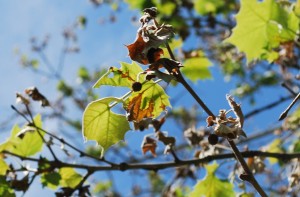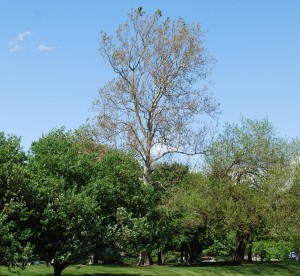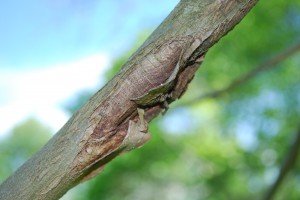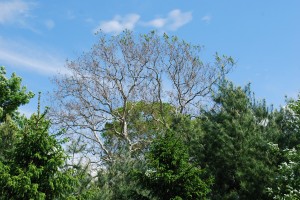Have you noticed in the landscape that the sycamores, and to a lesser degree, the plane trees are devoid of leaves? Anthracnose of Platanus species is a well known disease in our area. The disease causes leaf and shoot blight, twig cankers, and branch dieback, and has been particularly severe this spring.
The conventional wisdom with all leaf diseases in shade trees is that the fungus attacks newly expanding leaves during cool, wet periods in the spring. Fungal infections subsequently result in, depending on the disease, a myriad of spots, blotches and other deformities. With sycamore anthracnose, the leaf spots are angular and affiliated with the veins. Infected leaves are shed and entire canopies can be defoliated by early-summer.

Classic angular leaf spot and twig blight of sycamore anthracnose. Photo: Richard Buckley, Rutgers PDL
But what about this season? By all accounts, the trees never had leaves in the first place. While we are all well aware of the leaf disease phase of sycamore anthracnose, realize that the real plant health issue with this disease is the damage done to twigs and buds. The causal fungus of sycamore anthracnose, Apiognomonia veneta, overwinters in infected trees in small cankers. Mild weather during dormancy promotes fungus activity. New cankers form and old ones grow, which girdle young stems and cause the surrounding buds and twigs to die.
Prolonged periods of spring rains with temperatures at or below 53 to- 55ºF favor twig and bud disease. In years with conducive weather conditions, like this one, as many as 95% of the new buds are killed. Trees in this condition are left naked until mid-summer except for a few misplaced tufts of leaves here and there. Twig cankers persist and produce spores for 2 to- 3 years, so once infected, always infected. As such, older trees suffer more from year to year because they carry a higher load of the fungus.
Sycamore anthracnose is a spectacular disease. Affected trees stand out like sore thumbs in the tree line. Despite the seemingly severe nature of this disease – it is true that repeat infections weaken and deform the trees over time – it is clear that these old birds just keep on keeping on. And don’t worry, sooner or later, they’ll get some clothes on.
See Dr. Ann Gould’s previous post for general hints on management and control of spring-time fungal leaf diseases.




